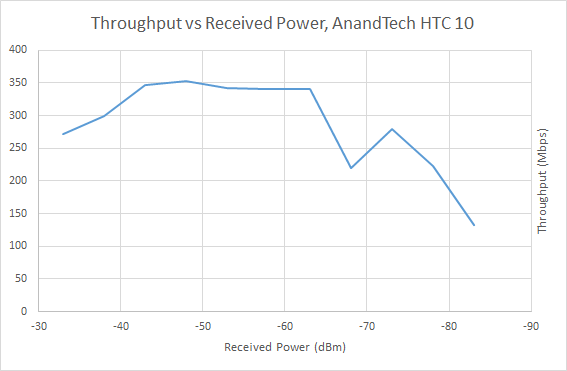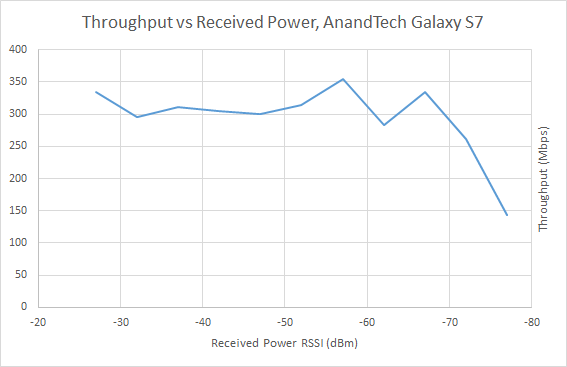The Samsung Galaxy S7 and S7 edge Review: Part 2
by Joshua Ho on July 5, 2016 8:00 AM ESTWiFi Testing with Ixia IoT
As previously discussed, RF testing has always been a major unknown to some extent because environmental factors make it extremely difficult to tell exactly what is going on with the system. I don’t think it really needs to be said but previous reviews and any controversy regarding the quality of RF has always lead to a ring of confusion and back and forth with no clear-cut answers, at least in the public domain. The Transformer Prime and Pixel C reception issues have all been cases where I’ve seen a lot of confusion over whether a problem really existed in the hardware, software, or with the end user.
Most people really don’t have any understanding of how wireless transmission works, probably because it’s not really something you can see. As far as I know, no one is capable of seeing radio waves, even at high frequencies like 60 GHz. Of course, the problem is that for quite some time our testing was also not really ideal for seeing the quality of an RF implementation. While iPerf does provide some useful data, free space testing means that we’re dealing with channel conditions that inherently cannot be controlled. As a result, the only sensible test we could do with iPerf was focus on maximum throughput in the best conditions we could provide. The only thing that this can highlight is the upper bound of efficiency for WiFi due to the carrier sense multiple access scheme in most cases, and rarely detects a whole class of problems that affect user experience on WiFi.
In order to test these things we’ve moved to using a proper testing system that is actually used by at least a few OEMs today, namely Ixia IoT. While we discussed the possibilities for testing, at this time due to the RF isolation chamber used we are limited to AP simulation only, so we can’t properly simulate clients in the channel without restricting ourselves to a single spatial stream for both the AP and client. This wouldn’t be a very useful test if set up in this manner as most devices today that we’re testing have support for two spatial streams, and many routers have three or even four spatial streams at this point.
The first set of results we can talk about that will be of interest is rate vs range. This is a fairly simple test at a conceptual level, as it simply tries to see how well a device can maintain its performance in the face of reducing signal to noise ratio for a given modulation and coding scheme. This is a good high level test of how well a device can maintain a connection as reception degrades. In this test the HTC 10 had an initial RSSI of -28 dBm while the GS7 was at -21 dBm and the iPhone 6s at -22 dBm, which allows us to calculate the path loss and determine the RSSI as a function of the transmit power.
The results of this test are interesting to say the least. Off the bat, every device had different RSSIs measured, so this meant that everything had different levels of path loss. The HTC 10 seemed to have the most path loss, while the Galaxy S7 and iPhone 6s were functionally identical. However it looks like RSSI is really an insufficient metric here because while the iPhone 6s was able to reach maximum throughput using NSS 2 MCS 8, the HTC 10 and Galaxy S7 did its best at NSS 2 MCS 4 or 5. I suspect this may be just due to placement as device positioning strongly affects MIMO as receive-side spatial correlation reduces the gains that MIMO can provide. Regardless, the HTC 10 somehow manages to beat the Galaxy S7 through much of the curve, but for some reason suffers from a reduction in throughput at higher transmit power. It's worth mentioning though that this test doesn't allow for testing of antenna gain or similar tests. Given various levels of futzing about with the device positioning in the test chamber I'm fairly confident that the Galaxy S7 is consistently better with regard to path loss, so even if it doesn't perform as well at a given RSSI it tends to have a higher RSSI than the HTC 10 by about 5 dBm which is fairly significant.
Finally, the other test that we can run at this time is the roaming latency test, which tests how well a device can hop from one access point to another as the received transmit power rises and falls. If you ever rely on WiFi to work as you walk around any building larger than a single apartment unit, you’re going to feel the effects of high roaming latency as VOIP calls or any real-time network application will either experience interruption or drop altogether if roaming is not implemented properly.

In the case of the Galaxy S7, roaming latency is honestly rather wanting. In the best case the Galaxy S7's roaming latency appears to be acceptable, but it's still significantly worse than the best we've seen so far. It seems that Samsung's algorithms have issues with edge cases as I've seen multiple instances so far where the device just can't handle roaming consistently. Despite consistent positioning and identical test setup I've seen cases where the Galaxy S7 has problems with consistent roaming. Even with the simple case of 10 dBm to -45 dBm at 3 dBm drop per second, I've encountered weirdness where the device drops from the network altogether claiming that the password given was incorrect (it wasn't) or a few successful handovers followed by getting stuck on a single access point or dropping from the network entirely. Even in the best set of trials performed I still saw 3 of 64 trials fail to roam correctly. The performance is certainly far better than something like the Google Pixel C, but Samsung should really be focusing on improving here.













266 Comments
View All Comments
phexac - Tuesday, July 5, 2016 - link
"I heard iphone sales are an all time low. Are you suggesting Apple is still selling more iphones than Samsung is selling their Galaxy series?"Yes, by a lot.
Not to mentioned, that "iphone sales have declined for the first time quarter over quarter" does not mean "iphone sales are an all time low," which would imply that iphone sales are zero since there were no iPhones pre-2007.
retrospooty - Tuesday, July 5, 2016 - link
"Yes, by a lot."- that is not correct. Samsung sells more phones than anyone. Samsung outsells Apple by a HUGE margin, not just a little. Apple sells the most of a single model, because they only have a few each year, but Samsung vastly outsells Apple in total, consistently every year without exception.
michael2k - Tuesday, July 5, 2016 - link
The question was Galaxy vs iPhone, not Samsung vs iPhone. In terms of Galaxy S, their flagship phones are selling far fewer than flagship iPhones, per quarter. Not entirely sure about their entire Galaxy range, but Samsung doesn't sell many more phones than Apple in some quarters:http://www.gartner.com/newsroom/id/3215217
retrospooty - Wednesday, July 6, 2016 - link
m2k, what are you even arguing here? Samsung outsells all other makers, consistently every quarter - always, without fail. They are huge. They are the Toyota of phones. FWIW, I dont think that is a good thing, but it is what it is and no amount of debate will change it.KoolAidMan1 - Saturday, July 9, 2016 - link
"Samsung sells more phones than anyone. Samsung outsells Apple by a HUGE margin"The majority of those phones are low end models, just like the rest of the Android ecosystem. If we're only comparing high end models like the GS6 and GS7 it is still far outsold by the iPhone. This is reflected in higher app revenue, higher web traffic, higher ad revenue, and so on coming from iOS as it always has.
You are being intellectually dishonest as usual by omitting important information.
Ratman6161 - Tuesday, July 5, 2016 - link
Not really true that they are "at an all time low". See: http://www.statista.com/statistics/263401/global-a...Growth rate is at an all time low but that's true of smartphones in general. Its the same reason that PC sales leveled off a couple of years ago. PC's became fast enough/good enough to the point where there was just no reason to replace the one I already have. Example: I've got an i7 2600K system I built when that CPU was new in 2011 and its still overkill for most of what I do. Likewise, when I got my Galaxy Note 5 last November, I finally had a phone that was fast enough for anything and everything I do. Unless what I do with a phone changes radically (which I doubt will happen any time soon) I'll have no reason to replace it until the hardware dies.
As far as Apple selling more phones than Samsung, that has really never been true unless you only consider the US market. Globally, Samsung has always sold more. Even in the US, Android overall has greater market share than iOS. Apple is the largest single company because its got a lock on iOS where Android is spread out among many companies.
HardwareDufus - Tuesday, July 5, 2016 - link
Huge Apple Bias. Evident by the fact there is not a single review of the Lumia 1520, the 'flagship' Windows phone for the better part of two years.However, I understand that and don't fault them for it. I just read each article predisposed to the idea that the writers are predisposed to favor the apple version of whatever they are reviewing. So be it.
Anandtech objectivity slid about 2 years before Anand himself actually left. They're just mirroring the rest of the tech blogosphere.... writers/reviewers/editors have mouths to feed. Everybody is beholding to whoever is writing the check and each piece of content will reflect that. Our modern enlightened world. Same greed. Same game.
fanofanand - Wednesday, July 6, 2016 - link
Anand (who I still admire) showed the way, shill long enough and you will land a cushy job in Cupertino.dsumanik - Tuesday, July 5, 2016 - link
Actually no.This site, like many other review sites, receives money directly, or indirectly for writing positive apple coverage, especially in the the articles of their fiercest competitors.
Then marketing shills like you come on here and quote sales figures in the comment sections, again paid for directly, or indirectly by apple.
Oh and instead of just making statements to justify your argument...heres proof:
http://www.ibtimes.com/apples-ios-still-getting-cr...
IOS is just a drop in the smartphone bucket, theres no internet BIAS, it's the author 100%.
michael2k - Tuesday, July 5, 2016 - link
I wish Apple paid me for my posts.What you're seeing, as retrospooty correctly surmised, is that Anandtech is in fact biased, but not towards Apple or away from Samsung, but towards the readers that pay their bills via ad impressions and click through. What he wishes is that the site cater more towards him, even if he is a smaller part of the readership.